Beginning Teachers Add to Their Hands-On Repertoire at INTC STEM Conference
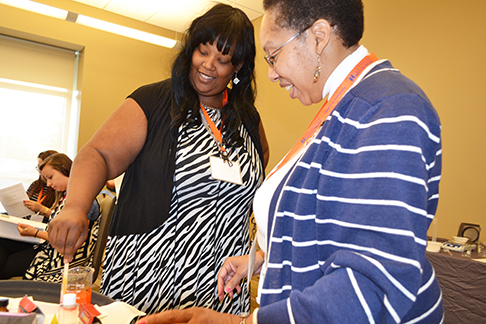
Two teachers in Joe Muskin's session try out a chemical engineering hands-on activity as they add fragrance and color to the shower gel they created.
July 31, 2014
On July 29–30, 2014, 100+ teachers from all over the state attended the 2nd Annual Beginning Teacher STEM Conference hosted by the Illinois New Teacher Collaborative (INTC). Held at the I-Hotel on campus, the conference targeted new teachers in their first through fourth years of teaching, plus some of their mentors. A total of 150 teachers registered for the conference, which featured keynote speaker Jeff Goldstein, director of NCESSE (the National Center for Earth and Space Science Education), 30 different break-out sessions, opportunities for networking, a panel of award-wining teachers, and an "Unconference" session, where the teachers themselves presented lessons/activities.
The conference was designed for secondary STEM teachers (such as a high school physics teacher, for example), as well as primary teachers, many of whom teach a number of STEM subjects (such as, for example, a kindergarten teacher who teaches math).
One such teacher, Talibah Mance, a 4th grade teacher from Betty Shabazz Academy in Chicago attended the conference because she needed a refresher on STEM subjects, including science.
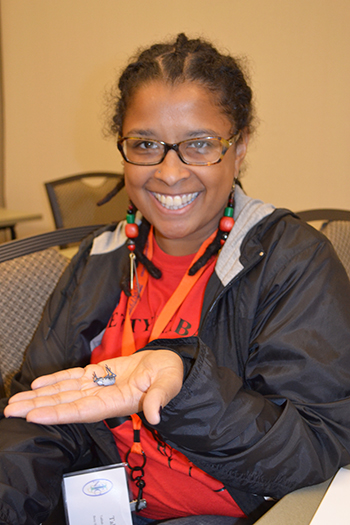
Tabliah Mance, a fourth grade teacher from Shabazz School, gets to see a blue, death-feigning beetle play dead during a break-out session on bringing insects into the classroom.
"I really needed to get information about incorporating STEM in my classroom. Last year I just taught social studies and English Language Arts, so I wanted to refresh what I haven't been teaching for a while."
After sitting in on a number of sessions, did Mance believe she would implement some of what she learned at the conference in her classroom? "Absolutely, says Mance. "The hands-on bug workshop that we just went to was fabulous, especially for my age group. Then I have a teacher at my school that I can collaborate with that teaches second grade. So it'd be great for us to do this together, and have the older children help the younger ones."
One unique aspect which both the teachers (and their district administrators most likely) appreciated: the STEM conference was free, thanks to the funding supplied by the conference's sponsors: Governor's State University, the College of Engineering and the College of Education at Illinois, and the State Farm Companies Foundation.
For instance, one participant who appreciated the lack of a registration fee was Victoria Taylor, who teaches sixth grade science at Lincoln Middle School. In her third year of teaching, Taylor registered after receiving an email alerting new teachers.

Victoria Taylor, the Lincoln Middle School sixth-grade science teacher.
"This is a free conference, which was a huge appeal for a starting-out teacher to go to a free conference," admits Taylor.
What from the conference does Taylor think she will take back to her classroom?
"First of all, the enthusiasm," says Taylor. "The keynote speaker really pumped up the teachers…that was the extra boost that we needed, just to say, "There are still people out there cheering for you, that want you to go back to make sure that science and STEM subjects, in general, are really promoted in the classroom so you can get students excited about it. So I can take that back."
Why would a STEM conference be needed for beginning teachers, most of whom had very likely recently finished at least four years of schooling?
According to former INTC Director Patricia Brady, a teacher's education shouldn't be over just because they've received their degree and entered the classroom, "We like to think of a continuum of teacher development. It's not as though as soon as you get that license, suddenly, there's nothing else to learn. And even if you're a 25-year veteran, you can still learn new things."
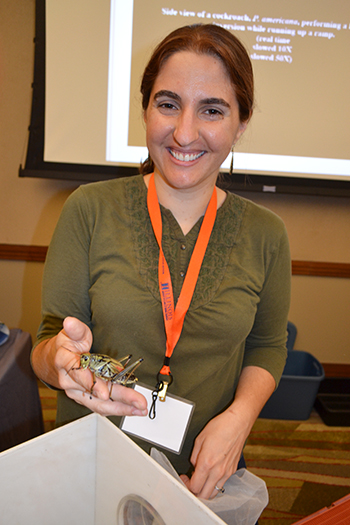
Catherine Dana holds a large grasshopper that can be found in southern Illinois.
Many components included in the conference were based on research the Collaborative has conducted looking at resources available to new teachers across the state.
"We find that beginning teachers who are lucky enough to land a job in a larger district, in a suburban or urban district, a more well-funded district, they're going to get a mentor;" says Brady. "They're going to get workshops, professional development, observations, many different layers of support. Beginning teachers who are in small districts, rural districts, under-funded and high-poverty districts—the very teachers who need the most support—are the ones least likely to get it."
So conference organizers hoped to rectify some of those omissions. For example, break-out sessions addressed subject matter ranging from science, technology, engineering, and math, to sustainability, robotics, how to use live insects in instruction, and how to build windmills. The hope was that teachers would return to their classrooms armed with a wealth of engaging, hands-on activities. In fact, Brady indicates that they "encourage the breakout session presenters to be as hands on as possible," so teachers can, "really see how this could be enacted in the classroom."
Sixth-grade science teacher Victoria Taylor appreciated the emphasis on hands-on, and felt many of the strategies regarding how to implement hands-on activities would be useful in her classroom:
"Just the ideas about how to integrate more hands-on, more broad STEM in general…because I teach science, so integrating that technology, engineering, and math; they've done a really great job of how to do that. All of the sessions have made sure to point out each of those in the sessions."
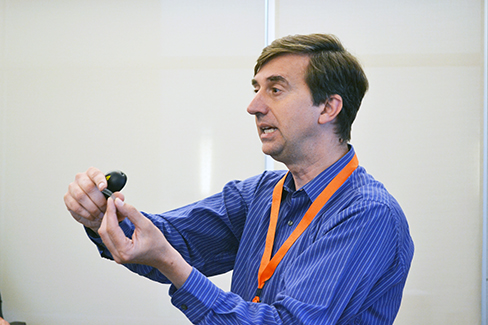
Joe Muskin explains the property of Nitinol to teachers in his session. An alloy of nickel and titanium, Nitinol is a memory metal whose shape can be changed; however, when placed in hot water, it returns to its original shape.
Presenting at the conference were a number of the university's STEM education "stars": Joe Muskin (previously of Nano-CEMMS, now education coordinator of MechSE), and Chemistry's Don DeCoste and Gretchen Adams. Also back by popular demand, Ph.D. student Annie Insana introduced foldable 3-D models students can build.
By inviting beginning teachers' mentors, conference planners sought to provide shared experiences to strengthen mentor-mentee relationships.
"It provides sort of an opportunity for them to attend a session together and then be able to talk about that..." says INTC Ph.D. student Alexis Jones, "or be able to have those professional conversations with the same background knowledge."
For teachers who lacked a mentoring relationship, built in to the conference were networking opportunities, such as the networking lunch and the reception the first evening. "A lot of what they get out of this is not just what they learn from the presentations," indicates Brady, "but their interaction with each other." Planners included networking times by grade level or content area, "so they are able to make these connections. These are people they can follow up with later, share resources."
In another unique session, dubbed an "unconference," teachers shared their own ideas with each other. Says Brady, "Instead of us bringing experienced teachers to tell the beginning teachers how to do it, we ask the beginning teachers to be resources for each other. We are not bringing in experts to tell you all about it; it's you realizing you are an expert yourself and what you can share with your peers."
Finally, the conference ended with a panel of award-winning Illinois STEM teachers, who shared their creativity and what they have found that works in the area of STEM.

Annie Insana demonstrates a foldable she used in her classes.
Charged with the mission of supporting beginning teachers across the state, INTC is not a STEM organization per se, but normally works with beginning teachers in all subject areas. So in addition to the STEM conference, they hosted an earlier conference in June for teachers finishing their first year in the classroom (any subject, any grade).
And while the two conferences work with beginning teachers directly, much of their work is with districts as a whole or with mentors and program coordinators who support beginning teachers. In addition to the conferences, INTC provides a variety of resources, including workshops, help with websites, training, professional development, and online resources.
Because INTC is not an organization solely devoted to STEM, why hold a STEM conference? Because it's such a needy area.
>"We realized there is so much need in STEM," says Brady, who then cites several scenarios. "Teachers, say in smaller rural districts, are isolated. You might be the only chemistry teacher in the whole district or the only science teacher in your district," but then adds, "Even teachers in larger districts who have a lot of resources still need professional development."
Brady also indicates that K–5 teachers receive pedagogy on how to teach younger students, "but their background in math and science might be slim." Plus, the new Next Generation Science Standards include engineering. "Well, who studied engineering in college?" she asks, then adds, "And there is always new technology to learn."
According to Brady, they ultimately hope the conference will enable them to impact more students in STEM…via multiplication: "This is a huge area that we could really make a difference in beginning teacher practice. The end result for us is student learning. So if we can impact 150 teachers, think of how many students we are impacting every single year."
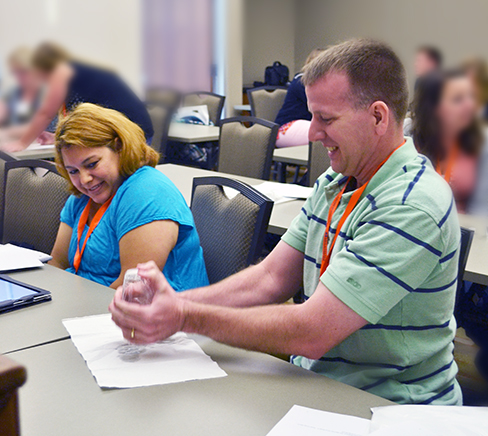
Two teachers do an activity in Don DeCoste and Gretchen Adam's breakout session on hands-on activities in the classroom using sugar cubes.
Story and photographs by Elizabeth Innes, Communications Specialist, I-STEM Education Initiative.
More: INTC STEM Conference, Teacher Professional Development, 2014
For additional I-STEM articles about the INTC Beginning Teacher STEM conference, please see:
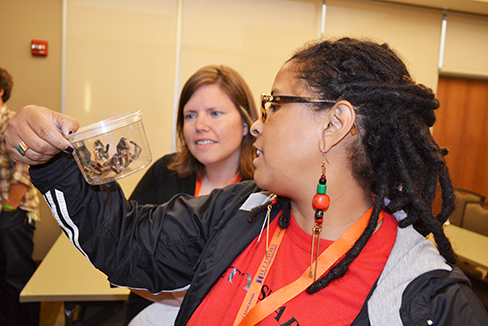
Lisa Ferguson (left) and Talibah Mance (right) examine a tarantula during the "Bringing Insects into the Classroom" breakout session.
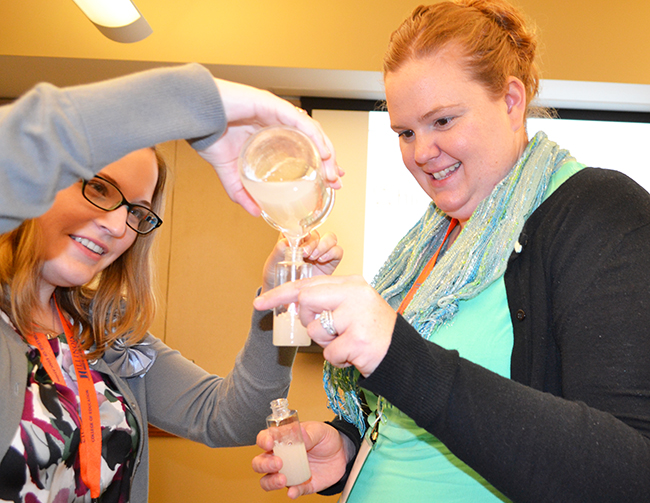
Two teachers make shower gel during Joe Muskin's workshop on Science and Engineering Labs.













.jpg)
















